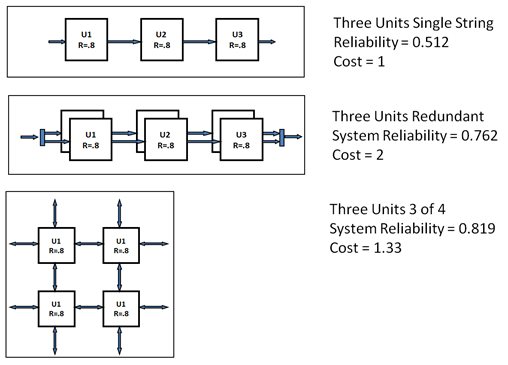Joint Architecture Standard Overview Profile
Advantages of JAS
A modern node-based architecture with reconfigurable node electronics and serial data links between nodes provides the core structure and flexibility needed to enable most of the design strategies. It offers a powerful, yet efficient, modular solution that can be scaled and configured to support payloads of virtually any size and complexity. It also offers the ability to leverage the vast array of modern standards and products that have been commercially developed for other industries with the flexibility to incorporate future technological advances without changing the fundamental architecture.
Cost and Complexity Advantages
A node-based architecture also offers reduced costs and schedules through reusability and a major reduction in proliferation of custom interfaces. Custom interfaces are major system cost drivers. They require labor-intensive negotiations, formally controlled Interface Control Documents (ICDs) and test plans, custom hardware and software designs, custom test equipment and laborious testing, and they tend to be a primary source of system design problems discovered late in the development cycle.
Serial Interface Advantages
Standard interfaces, provided by a node-based architecture, also reduce system cost and complexity by enabling and encouraging greater hardware and software reusability across payloads, projects and laboratories. They also tend to simplify the incorporation of new capabilities and technologies. Serial data links (as opposed to shared parallel buses) are chosen for several reasons:
- Higher bandwidth and processing throughput
- Fewer device number restrictions
- Reduced complexity
- Reduced pin and wire counts
- Greater physical flexibility
- Increased technology endurance
- Simplified redundancy
SWAP Advantages
If minimization of SWAP at any dollar and/or schedule cost is a program requirement, then a custom design may be the preferred solution; however, this is rarely the case. In today’s world, cost and schedule are very important design drivers – often more heavily weighted than SWAP. A carefully engineered node-based architecture strikes a good balance between system cost and SWAP. There are three reasons for its SWAP efficiency:
- Light-weight cables and connectors resulting from reduced pin count
- Lower cross-strapping hardware weight
- Potential for employing M-of-N redundancy
Reliability and Redundancy Advantages
The conventional approach for improving system reliability employs cold spares on a one-to-one basis where the entire payload is divided into a set of redundant functional units that are cross-strapped. This approach works well, but it has a significant weight cost, and cross-strapping adds design complexity.
A node-based architecture can be comprised of a mix of modules, some of which are redundant on a one-to-one basis and others that are redundant on an M-of-N basis, where M is less than N. In both cases, failure recovery is achieved by powering down and isolating the failed module from a network and switching in a spare to replace it. Cross-strapping is required in neither case. Provisions that make this implementation possible are interchangeability of certain common modules and the ability to connect in replacement units with adequate resources and bandwidth.
As an example, the figure below compares reliability and weight costs of traditional one-to-one sparing vs. 3-of-4 sparing. Note that the 3-of-4 approach achieves an improved reliability over the traditional approach with the addition of only one spare. Common reconfigurable processing nodes are examples of modules that are amenable to M-of-N redundancy.
This capability also enables options for graceful degradation in non-redundant systems since it is possible to reconfigure nodes assigned to lower-priority tasks to replace failed nodes assigned to higher-priority tasks.

Comparison of Redundancy Approaches
Communications Advantages
JAS features software that emphasizes the application-specific implementation that is abstracted from the processor, language, or operating system. This methodology facilitates the reuse of software and hardware through common communications.
JAS software will have the following application level features:
- Standard defined command and data packet format or protocol (based on CCSDS)
- Quality-Of-Service techniques and fault tolerant communications strategies
- Software “file system” protocols for data storage and communications
- Lightweight communication protocol
- Automated network discovery/declaration system